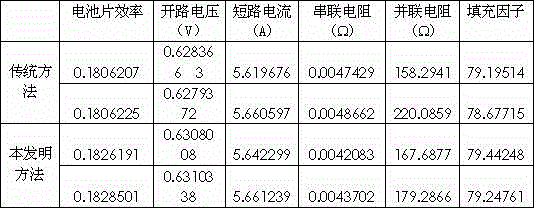Solar battery diffusion method
A solar cell and diffusion method technology, applied in the field of crystalline silicon solar cell manufacturing, can solve problems such as reduced filling, increased series resistance, and low-efficiency sheets in the production line, so as to reduce surface recombination and defect concentration, increase conversion efficiency, and improve The effect of conversion efficiency
- Summary
- Abstract
- Description
- Claims
- Application Information
AI Technical Summary
Problems solved by technology
Method used
Image
Examples
Embodiment 1
[0046] The raw material is P-type monocrystalline silicon wafer, the thickness is 200±20um, and the resistivity is 0.5-6W.cm. Place the slices in a diffusion furnace.
[0047] Step 1, the first oxidation
[0048] The temperature of the diffusion furnace is raised to 820°C, the flow rate of oxygen is 10slm, and the time of oxygen is 15min to form a 20nm oxide layer;
[0049] Step 2. Diffusion
[0050] 2.1, the first diffusion
[0051] The diffusion furnace is heated to 840°C, the flow rate of the small nitrogen is 1.2 slm, the flow rate of the large nitrogen is 9 slm, the flow rate of the oxygen is 1.3 slm, and the time for feeding the mixed gas is 6 minutes;
[0052] 2.2, the second diffusion
[0053] The diffusion furnace is heated to 850°C, the flow rate of the small nitrogen is 1.0 slm, the flow rate of the large nitrogen is 9 slm, the flow rate of the oxygen is 1.2 slm, and the time for feeding the mixed gas is 5 minutes;
[0054] 2.3. The third diffusion
[0055] Th...
PUM
 Login to View More
Login to View More Abstract
Description
Claims
Application Information
 Login to View More
Login to View More - R&D
- Intellectual Property
- Life Sciences
- Materials
- Tech Scout
- Unparalleled Data Quality
- Higher Quality Content
- 60% Fewer Hallucinations
Browse by: Latest US Patents, China's latest patents, Technical Efficacy Thesaurus, Application Domain, Technology Topic, Popular Technical Reports.
© 2025 PatSnap. All rights reserved.Legal|Privacy policy|Modern Slavery Act Transparency Statement|Sitemap|About US| Contact US: help@patsnap.com

